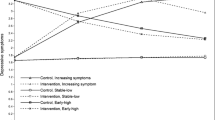Abstract
Differences among three outcome groups of late adolescents identified as at risk for major depression were investigated. Adolescents with major depression, with other psychiatric diagnoses, and with no diagnoses differed in major areas of functioning and well-being, with the most difficulties shown by those with depression. The phenomenon of resilience was examined among the at-risk adolescents with no diagnosis, revealing that family cohesion and social support are associated with resilience. Implications for social work practice and research include the need to focus on promoting family strengths.
Similar content being viewed by others
References
Achenbach, T. C. (1991). Manual for Youth Self-Report and 1991 Profile. Burlington, VT: University of Vermont Department of Psychiatry.
APA. (1987). Diagnostic and statistical manual of mental disorders, III-R. (Third, Revised ed.). Washington, D.C.: American Psychiatric Association.
Barrera, M. (1980). A method for the assessment of social support networks in community survey research. Connections, 3(1) 8–13.
Beardslee, W. R., Versage, E. M., Wright, E. J., Salt, P., Rothberg, P. C., Drezner, K., & Gladstone, T. R. G. (1997). Examination of preventive interventions for families with depression: Evidence of change. Development and Psychopathology, 109–130.
Beavers, W. R., Hampson, R. B., & Hulgus, Y. F. (1990). Beavers systems model manual. Dallas, TX: Southwest Family Institute.
Brooks, R. B. (1994). Children at risk: Fostering resilience and hope. American Journal of Orthopsychiatry, 64(4), 545–553.
Egeland, B., Carlson, E., & Sroufe, L. A. (1993). Resilience as process. Development and Psychopathology, 8(4), 517–528.
Egeland, B., Pianta, R., & Ogawa, J. (1996). Early behavior problems: Pathways to mental disorders in adolescent development and psychopathology. Development and Psychopathology, 8(4), 735–749.
Ensel, W. M., & Lin, N. (1991). The life stress paradigm and psychological distress. Journal of Health and Social Behavior, 32(4), 321–341.
Feehan, M., McGee, R., Williams, S. M., & Nada-Raja, S. (1995). Models of adolescent psychopathology: Childhood risk and the transition to adulthood. Journal of the American Academy of Child and Adolescent Psychiatry 34(5), 670–679.
Grilo, C. M., Walker, M. L., Becker, D. F., Edell, W. S., & McGlaskan, T. H. (1997). Personality disorders in adolescents with major depression, substance use disorders, and coexisting major depression and substance use disorders. Journal of Consulting and Clinical Psychology, 65(2), 328–332.
Harold, G. T., Fincham, F. D., Osborne, L. N., & Conger, R. D. (1997). Mom and Dad are at it again: Adolescent perceptions of marital conflict and adolescent psychological distress. Developmental Psychopathology, 33(2), 333–350.
Harrington, R., Rutter, M., & Fombonne, E. (1996). Developmental pathways in depression: Multiple meanings, antecedents, and endpoints. Development and Psychopathology, 8(4), 601–606.
Hart, D., Hoffmann, V., Edelstein, W., & Keller, M. (1997). The relation of child personality types to adolescent behavior and development: A longitudinal study of Icelandic children. Developmental Psychology, 33(2), 195–205.
Hollingshead, A. G. (1971). Commentary on “The indiscriminate state of social class measurement”. Social Forces, 49, 563–567.
Kerlinger, F. N. (1986). Foundations of social research, 3rd edition. Philadelphia: Holt, Rinehart and Winston.
Kraemer, H. C., Kazdin, A. E., Offord, D. R., Kessler, R. C., Jensen, P. S., & Kupfer, D. J. (1997). Coming to terms with the terms of risk. Archives of General Psychiatry, 54(4), 337–343.
Luthar, S. S. (1991). Vulnerability and resilience: A study of high-risk adolescents. Child Development, 62(3), 600–616.
Luthar, S. S., Doernberger, C. H., & Zigler, E. (1993). Resilience is not a unidimensional construct: Insights from a prospective study of inner-city adolescents. Development and Psychopathology, 5(4), 703–717.
Olson, D. H., Portner, J., & Lavee, Y. (1985). FACES III. In D. H. Olson, J. Portner, & Y. Lavee (Eds.), Family Inventories. St Paul, MN: Family Social Science, University of Minnesota.
Piers, E. V. (1984). The Piers-Harris Children's Self-Concept Scale, Revised Manual. Los Angeles: Western Psychological Services.
Reinherz, H. Z., Giaconia, R. M., Lefkowitz, E. S., Pakiz, B., & Frost, A. K. (1993a). Prevalence of psychiatric disorders in a community population of older adolescents. Journal of the American Academy of Child and Adolescent Psychiatry, 32(2), 369–377.
Reinherz, H. Z., Giaconia, R. M., Pakiz, B., Silverman, A. B., Frost, A. K., & Lefkowitz, E. S. (1993b). Psychosocial risks for major depression in late adolescence: A longitudinal community study. Journal of the American Academy of Child and Adolescent Psychiatry, 36(6), 1155–1163.
Rosenberg, M. (1986). Conceiving the self. New York: Basic Books.
Rutter, M. (1987). Psychosocial resilience and protective mechanisms. American Journal of Orthopsychiatry, 57(3), 316–331.
Rutter, M. (1994). Beyond longitudinal data: Causes, consequences, changes, and continuity. Journal of Consulting and Clinical Psychology, 62(5), 928–940.
Werner, E. E. (1989). High-risk children in young adulthood: A longitudinal study from birth to 32 years, American Journal of Orthopsychiatry, 59(1), 72–81.
Author information
Authors and Affiliations
Rights and permissions
About this article
Cite this article
Carbonell, D.M., Reinherz, H.Z. & Giaconia, R.M. Risk and Resilience in Late Adolescence. Child and Adolescent Social Work Journal 15, 251–272 (1998). https://doi.org/10.1023/A:1025107827111
Issue Date:
DOI: https://doi.org/10.1023/A:1025107827111



